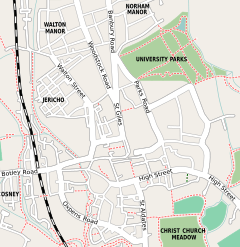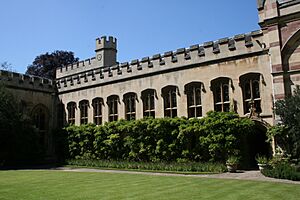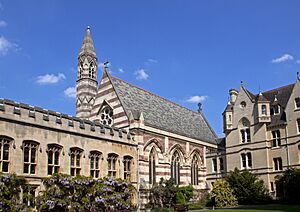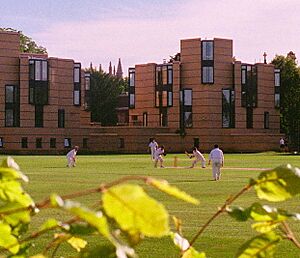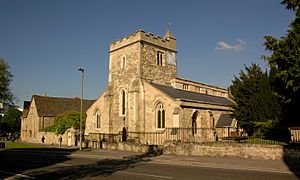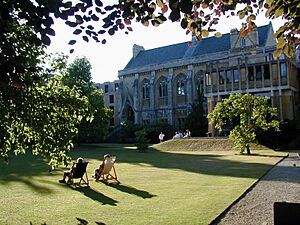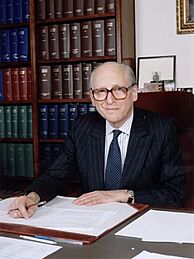Balliol College, Oxford facts for kids
Quick facts for kids Balliol College |
||||||||||||||||||
|---|---|---|---|---|---|---|---|---|---|---|---|---|---|---|---|---|---|---|
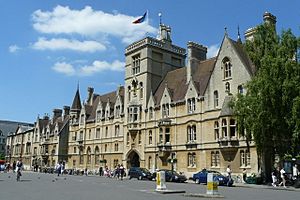 |
||||||||||||||||||
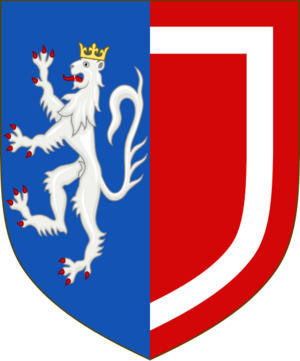
Blazon: Azure, a lion rampant argent, crowned or, impaling Gules, an orle argent
|
||||||||||||||||||
|
|
||||||||||||||||||
| University | University of Oxford | |||||||||||||||||
| Location | Broad Street, Oxford, OX1 3BJ | |||||||||||||||||
| Coordinates | 51°45′17″N 1°15′28″W / 51.7547°N 1.2578°W | |||||||||||||||||
| Full name | Balliol College | |||||||||||||||||
| Latin name | Collegium Balliolensis | |||||||||||||||||
| Established | 1263 | |||||||||||||||||
| Named for | John I de Balliol | |||||||||||||||||
| Sister college | St John's College, Cambridge | |||||||||||||||||
| Master | Dame Helen Ghosh | |||||||||||||||||
| Undergraduates | 366 (2017–18) | |||||||||||||||||
| Postgraduates | 359 | |||||||||||||||||
| Boat club | Balliol College Boat Club | |||||||||||||||||
| Map | ||||||||||||||||||
Balliol College (pronounced BAY-lee-ul) is a famous college at the University of Oxford in England. It was started in 1263 by John I de Balliol. Many people believe it is the oldest college in Oxford and even in the English-speaking world.
Students and teachers from Balliol have won 13 Nobel Prizes. This is more than any other Oxford college. Four prime ministers of the United Kingdom studied here. Other famous people include Harald V of Norway, Empress Masako of Japan, and President Richard von Weizsäcker of Germany.
Well-known alumni also include the economist Adam Smith and the author Aldous Huxley, who wrote Brave New World.
Contents
History of Balliol College
How Balliol College Started
Balliol College was founded around 1263 by John I de Balliol. He got help from Walter of Kirkham, who was the Bishop of Durham. A story says that John de Balliol had a disagreement with the bishop. As a punishment, he had to support a group of students in Oxford.
After John de Balliol died in 1268, his wife, Dervorguilla of Galloway, made sure the college would last. She gave money and wrote the college rules in 1282. These rules are still around today.
Balliol College claims to be the oldest Oxford college. However, University College and Merton College also make this claim. Balliol says its group of scholars started around 1263. Merton was the first to get official rules in 1274. University College was planned in 1249 but officially started around 1280. Each college has a good reason for its claim, depending on how you define "oldest."
New Inn Hall Joins Balliol
In 1887, a medieval student hall called New Inn Hall became part of Balliol College. This happened because of a rule made in 1881. Balliol took over New Inn Hall's student records and its library. The old New Inn Hall site was later sold. It is now part of St Peter's College, Oxford.
The Masque of Balliol Rhymes
In 1880, seven students from Balliol wrote funny poems about their teachers and themselves. They called it The Masque of B-ll--l. The college leaders were very upset and quickly stopped the poems from being shared. Only a few copies survived.
The most famous poem is about Benjamin Jowett, who was the Master of the college. These types of poems are now known as Balliol rhymes.
Women at Balliol College
For over 700 years, only men could attend Balliol College. In 1971, the college decided to allow women. This change was approved in 1977. In 1973, Carol Clark became the first female teacher at an old all-male college.
Before women could study as undergraduates, Balliol started a program for male and female graduate students. This was with St Anne's College in 1967. It meant men and women studied together at the Holywell Manor site. When women were fully admitted to Balliol in 1979, this joint program ended. Holywell Manor is now only part of Balliol College.
In 1979, Balliol welcomed its first female undergraduate students. To celebrate 30 years of women at the college, a sundial was put in the Garden Quad in 2010. It says "About Time." In 2018, Dame Helen Ghosh became the college's first female Master.
Between 2015 and 2017, about 39.4% of UK undergraduate students admitted to Balliol were women.
Buildings and Grounds at Balliol
Balliol College has been in its current location since it started in 1263.
Front Quadrangle

The oldest parts of the college are the north and west sides of the front quadrangle. These were built in 1431. The old dining hall is on the west side, and the "old library" is on the first floor of the north side. Balliol's second library was built before printed books were common in Europe.
William Grey, a bishop, gave a lot of money to the college in the 1400s. He collected many old books and wanted them to be part of Balliol's library. He helped build the library and other parts of the college.
The chapel is the third (or maybe fourth) one on this site. It was designed by William Butterfield in 1857.
Alfred Waterhouse designed the main front of the college on Broad Street in 1867–68. This includes the gateway and tower. These are known as the Brackenbury Buildings.
Garden Quadrangle
The Garden Quadrangle has several buildings from different times. The dining hall was built in 1877. It replaced an older, smaller hall. This new hall was also designed by Alfred Waterhouse. It has a special organ inside. The old hall became part of the library.
Underneath part of the Garden Quad were the Balliol-Trinity Laboratories. These were important science labs in the late 1800s and early 1900s. Famous scientists like Henry Moseley and Cyril Hinshelwood worked there. These labs are not used anymore.
The Garden Quad is also famous for a funny poem (limerick) about a philosopher named Bishop Berkeley.
Holywell Manor and Jowett Walk
Most graduate students live in the Holywell Manor complex. Balliol bought this building in 1932. It has art by former students and hosts events. Holywell Manor is a central place for graduate students. It has common rooms, gardens, and a student-run bar. Famous people like Bill Clinton and Masako, Empress of Japan have lived there.
Many undergraduate students live in buildings on Jowett Walk. These buildings were built between 1996 and 2004. They are close to the Master's Field, which is the college's sports ground.
Since 2010, St Cross Church, next to Holywell Manor, has been the college's Historic Collections Centre. It is an extension of the library. This old church is a very important historical building.
In 2017, the college started a project to build new student housing. This will add about 140 new rooms. It will allow the college to house all its undergraduate students. The project includes ten new buildings and a new sports pavilion. The first building opened in 2019, and the rest are expected to be finished by January 2021.
Oxford Internet Institute
Balliol College helped create the Oxford Internet Institute in 2000–01. This was the first research center in a European university to study how the Internet affects society. It is located within Balliol's grounds.
Student Life at Balliol
Facilities for Students
Balliol College gives its students many facilities. These include places to live, a dining hall, a library, and two bars. There are also common rooms for teachers, graduate students, and undergraduate students. The Junior Common Room (JCR) offers laundry, a student-run bar, and a cafeteria.
The college has a garden quadrangle and a sports ground called the Master's Field. The sports ground is used for cricket, tennis, hockey, and football. Students can also play croquet there.
Most undergraduate students live in the main college or the Jowett Walk buildings. Graduate students mostly live in Holywell Manor. It has its own bar, gardens, and gym.
Traditions and Customs
Balliol College has many old traditions. The college's special saint is Saint Catherine of Alexandria. On her feast day (November 25), a formal dinner is held for all final-year students.
Another important event is the Snell Dinner. This dinner remembers John Snell, who gave money for students from the University of Glasgow to study at Balliol. Adam Smith, a famous economist, was one of these students.
The most unusual event is the Nepotists carol-singing. This happens on the last Friday of the autumn term. Students gather in the hall for mulled wine and carols. The evening often ends with singing "The Gordouli" outside Trinity College.
College Tortoises
Balliol College also has college tortoises! The first tortoise, named Rosa, lived at the college for over 43 years. Every June, tortoises from different Oxford colleges have a slow race at Corpus Christi College. Rosa won many times. Rosa disappeared in 2004.
In 2007, a new tortoise named Matilda came to Balliol. She died in 2009. Now, a student is chosen each year to be the "Comrade Tortoise" and take care of the college's resident tortoise.
Balliol–Trinity Rivalry
For many years, there has been a strong rivalry between students from Balliol and its neighbor, Trinity College. This rivalry shows up in sports, on the river, and through songs sung between the colleges. It's similar to the rivalry between Trinity College, Cambridge, and Balliol's sister college, St John's College, Cambridge.
The rivalry is said to have started in the late 1600s. But in its current form, it seems to be from the late 1890s. That's when the song called "a Gordouli" started being sung from the Balliol side.
Singing chants over the wall is still called "a Gordouli." The tradition continues when students sing after boat club dinners. A story says that Balliol and Trinity men even sang the traditional Gordouli together in the trenches during the First World War.
Balliol became known for its strong political views in the 1900s. Many Balliol students had radical ideas, while Trinity was more traditional. This difference added to the rivalry.
In a book by Dorothy L. Sayers, a character from Balliol says he never knew any Trinity men. This shows how strong the rivalry was. One funny event in the 1960s was when Balliol students covered Trinity's common room with grass and flowers.
Famous People from Balliol
Many people who have made big contributions to public life studied or taught at Balliol. For example, Balliol people helped start the International Baccalaureate, the National Trust, and Amnesty International.
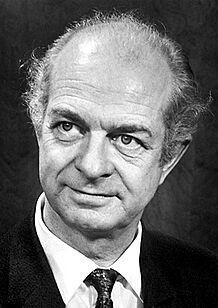
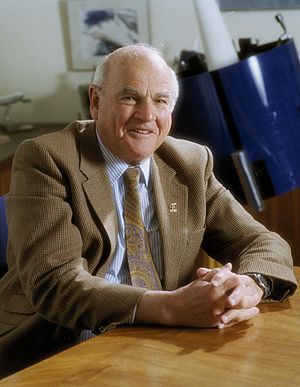
Nobel Prize Winners
Five former Balliol students and seven teachers have won Nobel Prizes. Linus Pauling even won two!
| Name | Field | Year |
|---|---|---|
| Linus Pauling | Chemistry | 1954 |
| Cyril Norman Hinshelwood | Chemistry | 1956 |
| George Beadle | Physiology or Medicine | 1958 |
| Linus Pauling | Peace | 1962 |
| John Hicks | Economics | 1972 |
| Gunnar Myrdal | Economics | 1974 |
| Baruch S. Blumberg | Physiology or Medicine | 1976 |
| John Van Vleck | Physics | 1977 |
| Robert Solow | Economics | 1987 |
| Norman Ramsey | Physics | 1989 |
| William D. Phillips | Physics | 1997 |
| Anthony J. Leggett | Physics | 2003 |
| Oliver Smithies | Physiology or Medicine | 2007 |
Science
Balliol played an important role in early modern science:
- David Gregory was the first to openly teach Isaac Newton's ideas.
- James Bradley discovered important facts about how the Earth moves.
Evolutionary biologist Richard Dawkins was a Balliol student from 1959 to 1962.
Politics
Balliol has educated four British Prime Ministers:
Other important leaders include:
- Richard von Weizsäcker, who was President of Germany and helped reunite Germany.
- Sir Sereste Khama, the first President of Botswana.
Royal alumni:
- Empress Masako of Japan
- Olav V of Norway
- His son, the current king, Harald V of Norway
Law
- John Marshall Harlan II was a very important US Supreme Court justice.
- Thomas Bingham was the top judge in the United Kingdom.
- Cressida Dick was the first woman to be the Commissioner of the London Metropolitan Police.
Literature
- Robert Southey, a Poet Laureate, wrote the original "Goldilocks and the Three Bears."
During the Victorian era, many major poets had ties to Balliol:
- Gerard Manley Hopkins, known for his unique poetry.
- Matthew Arnold, an important poet and critic.
- A.C. Swinburne, nominated for the Nobel Prize in Literature many times.
20th-century writers include:
- Graham Greene, a leading novelist.
- Aldous Huxley, author of Brave New World.
Philosophy
Notable Balliol philosophers include:
- Adam Smith, known as "The Father of Economics."
- Derek Parfit, a very important moral philosopher.
Sport
Balliol has also contributed to sports. I. A. K. Pataudi and his son Tiger Pataudi were both captains of the India cricket team. US Olympic rower Caryn Davies also studied at Balliol.
Other Notable People
Andrew Copson, the Chief Executive of Humanists UK, graduated in 2004. The first person known to brew coffee in England, Nathaniel Canopius, was a student at Balliol in the 1600s.
Chancellors of Oxford University
Many Balliol members have become Chancellor of Oxford University:
Teachers and Fellows
Balliol College has a group of teaching staff called Fellows. These include tutorial fellows and professorial fellows. Professorial fellows are professors from the university who are part of the college. For example, the Beit Professor of Commonwealth History is a fellow here.
The college can also choose "distinguished persons" to be honorary fellows.
Masters of Balliol College
Balliol College is led by the Master and the Fellows. The Master is chosen as the person best suited to lead the college. The current Master is Dame Helen Ghosh. She used to be a high-ranking official in the government and at the National Trust.
Most Masters have been former students or teachers of the college. Baruch Samuel Blumberg, a former student, was the first American Master and a Nobel Prize winner. The previous Master, Sir Drummond Bone, was also a former student.
Images for kids
-
Shoghi Effendi, Guardian of the Baháʼí Faith
-
Aldous Huxley, writer and philosopher
-
Adam Smith, economist and author
See also
 In Spanish: Balliol College para niños
In Spanish: Balliol College para niños


